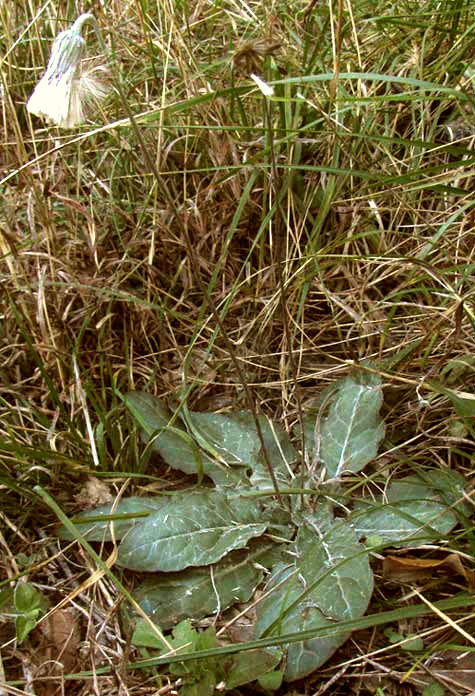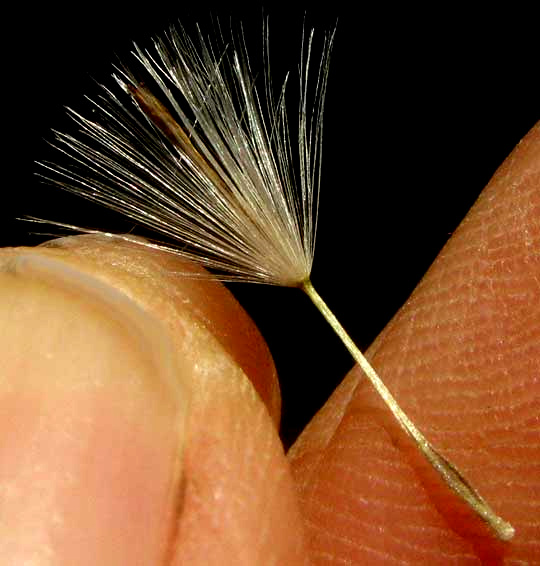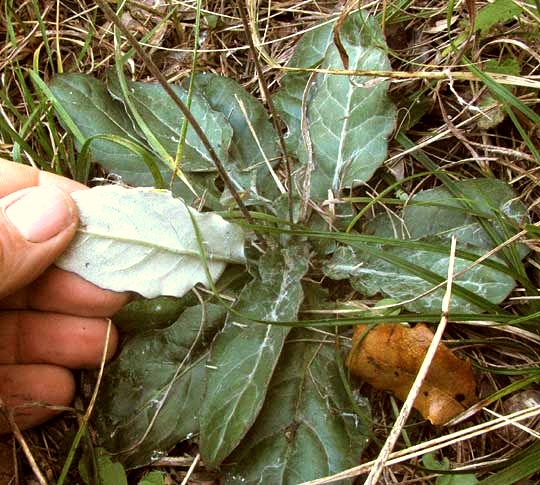Excerpts from Jim Conrad's
Naturalist Newsletter
from the December 22, 2013 Newsletter issued from the Frio Canyon Nature Education Center in the valley of the Dry Frio River in northern Uvalde County, southwestern Texas, on the southern border of the Edwards Plateau; elevation ~1750m (~5750 ft); N29.62°, W99.86°; USA
SILVERPUFF
I keep thinking I've seen my last new-for-me wildflower of the year, but new ones keep coming along. This week in grass on deep soil at the shady base of a low limestone ridge running along the Dry Frio River the vaguely dandelion-like, one-flowered herb turned up shown below:

The plant had already flowered, so the nodding, head shown on its leafless stem, or peduncle, consists of a collection of white-parachuted fruits that will be dispersed with the wind, like those of the dandelion. Of course, seeing the head structured so like an almost-mature dandelion head, we know that the plant, like the dandelion, is a member of the Composite, Daisy or Sunflower Family, the Asteraceae.
Up close you can better make out the white hairs forming the parachutes, especially because one fruit has worked its way out of the head, deployed its parachute, and is about ready to fly away. This is shown below:

That picture also provides a fine view of the greenish, overlapping, sharp-pointed scales known as phyllaries, which constitute the involucre inside which the florets and fruits develop. Note that the phyllaries and peduncle are both mantled with white, cobwebby hairs. On the fruit that's ready to fly away we can see that its parachute hairs actually are a little tawny colored, and that instead of arising directing from the long, narrow, three-ribbed, cypsela-type fruit, they radiate from the tip of a slender neck atop the cypsela, as seen below:

The plant's leaves all arise from the ground forming a basal rosette. They're also covered with white, cobwebby hairs, though their tops are much less densely hairy than their bottoms, which are surprisingly white and fuzzy-feeling, as shown below:

Despite retaining no flowers -- which the Flora of North America tells us are cream colored, turning crimson -- this wildflower is unusual enough with its single, nodding head and basal leaves mantled with cobwebby hairs that it was easily identified as what often is called the Silverpuff, CHAPTALIA TEXANA. Silverpuffs are distributed mostly in arid northern Mexico, but extend into the US in south-central New Mexico and southern Texas. The Flora of North America describes its habitat as "Slopes in thin, rocky (limestone) soils, usually in woods with abundant oaks; 200–1500 m," and that's exactly where it occurs here.
The genus Chaptalia is limited to the Americas, with its sixty or so species being mostly tropical and subtropical. Three species occur in the US. In Texas some botanists recognize the species Chaptalia carduacea, but most experts regard this as no more than a regional variation of C. texana, and the Flora of North America doesn't even deign to mention it. If someday C. carduacea is more generally recognized, then our plant would fit best under that name.
In Duke's Handbook of Medicinal Plants of Latin America, the species Chaptalia nutans, of which our C. texana sometimes has been regarded as a variety, has been used traditionally for "cleansing the blood and digestive system as part of an aphrodisiac," plus so many other uses are documented that you wonder if any are valid.